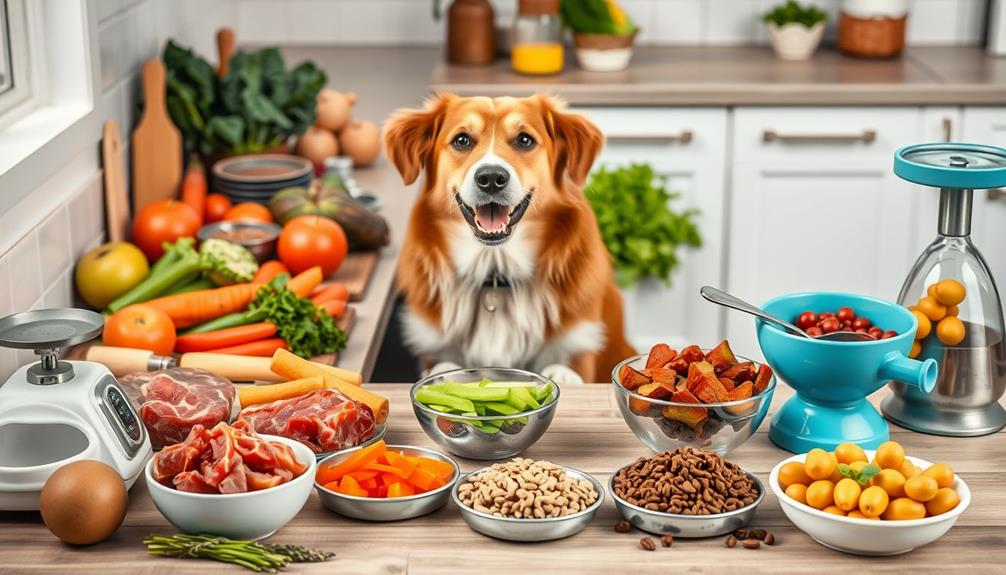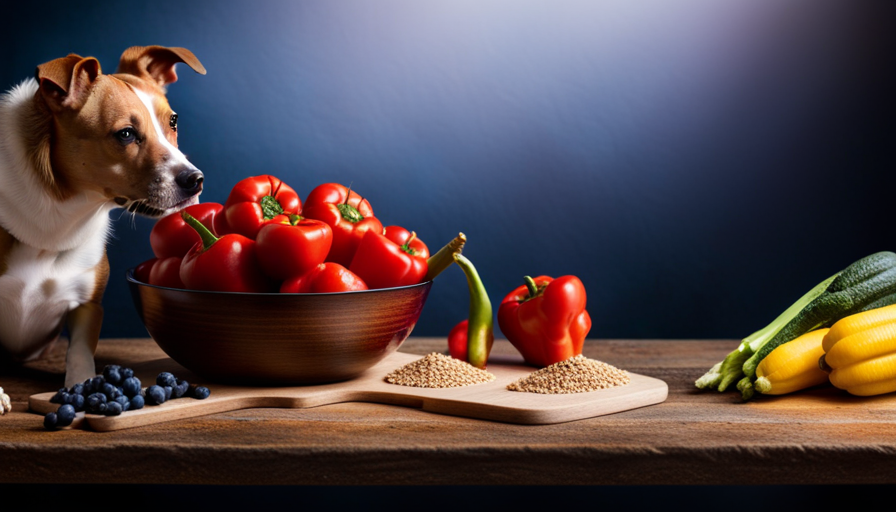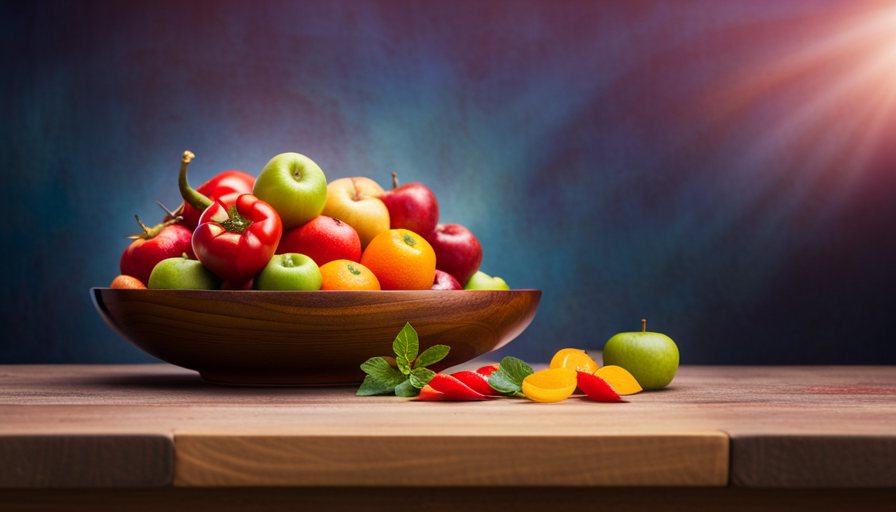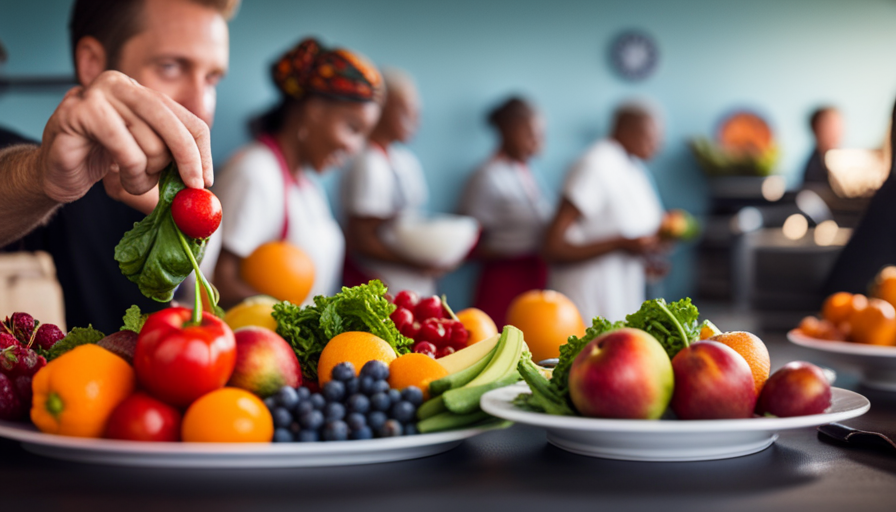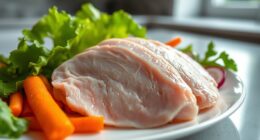You can switch your dog to a raw food diet, but a careful approach is vital. Gradually shift over 7 to 10 days, starting with mostly kibble while you increase the raw portions. Keep an eye on your dog's digestion and make sure they stay hydrated. You might need to enhance the meals with treats or low-sodium broth to make them appealing. Monitor their health closely for any signs of distress or adjustment. It's important to choose high-quality, balanced ingredients that meet AAFCO standards. If you explore further, you'll uncover more tips on making a successful switch.
Key Takeaways
- Transition to a raw diet should be gradual, ideally over 7 to 10 days, monitoring for digestive issues throughout the process.
- Incorporate flavor enhancers like cheese or bone broth to make raw meals more appealing for your dog.
- Ensure the raw food is of high quality, with human-grade ingredients and adherence to AAFCO nutritional standards.
- Monitor your dog's health during the transition, looking for signs of adaptation such as firmer stools and decreased stool frequency.
- Consider breed-specific dietary needs and adjust portion sizes accordingly to prevent obesity and support overall health.
Transitioning to a Raw Diet
Shifting your dog to a raw diet can be a smooth process if you take it step by step. Begin by implementing a gradual changeover over 7 to 10 days. Start with a mixed diet of 75% kibble and 25% raw dog food, slowly increasing the raw portion until you reach 100% by day 10.
For older dogs or those with sensitive stomachs, extend this changeover to 4 to 6 weeks to minimize gastrointestinal upset. It's also important to guarantee that the raw diet you choose is nutritionally balanced, much like how proper diet for pets is essential for their health.
Monitoring your dog during this period is vital. Watch for signs of gastrointestinal distress, like vomiting or diarrhea, which may indicate that your dog needs a more gradual introduction.
As you changeover, consider incorporating probiotics to support your dog's digestive health, helping them adjust more comfortably to the new diet.
Be aware that detox symptoms, such as loose stools and increased shedding, may occur as your dog expels accumulated toxins from their previous diet. These symptoms are often temporary and part of the adjustment process.
Making Raw Meals Appealing
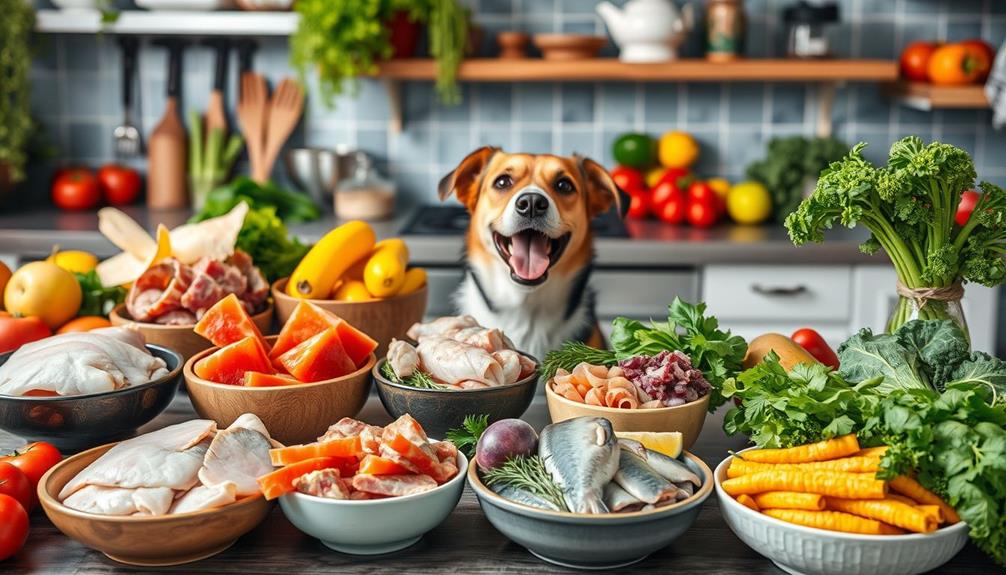
Once your dog has adjusted to the raw diet, making their meals more appealing can enhance their dining experience. Consider adding cheese or their favorite treats to the mix; these additions can make the food more enticing.
You might also incorporate eggs or canned sardines, which provide additional flavor and nutritional benefits that dogs may enjoy. Experimenting with different toppings can be similar to how coffee enthusiasts explore various coffee varieties to find their favorites.
Using low-sodium bone broth or goat's milk as a topping not only enhances moisture but also adds flavor, encouraging your dog to accept raw food more readily.
If you want to entice your dog further, lightly searing the meat before serving can release enticing aromas that draw them in. However, you can gradually reduce this once they adapt.
Health Monitoring During Transition
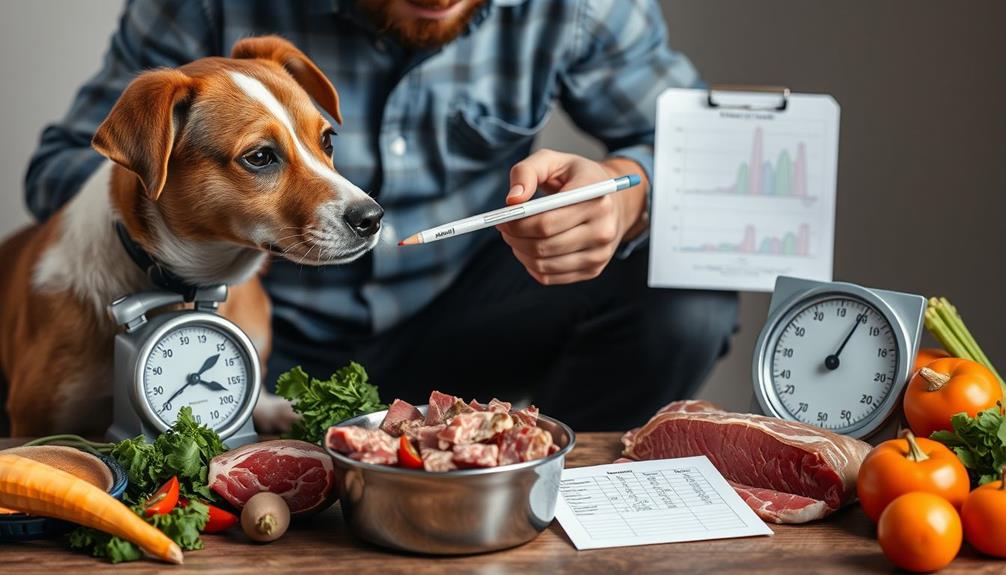
Shifting your dog to a raw diet requires careful health monitoring to guarantee their well-being. During the adjustment period, your dog may experience detox symptoms like vomiting and loose stools. These reactions can last from days to several months, depending on their previous diet and health status.
It's important to monitor changes in digestion and hydration, as raw food's moisture content may impact their overall water intake. Always provide fresh, clean water. Additionally, consider incorporating healthy snacks that contain natural ingredients to support their overall health.
To help firm up stools, consider adding plain canned pumpkin to their meals, and probiotics can support digestive health during this modification. Keep an eye on stool output; a decrease in frequency and firmer stools often indicates successful adaptation.
Regular veterinary check-ups are vital during this time to address any adverse reactions and confirm your dog's health is on track.
Benefits of a Raw Diet

Switching your dog to a raw diet can lead to enhanced nutritional absorption, helping them get the most out of their meals. In addition to improved nutritional absorption, a raw diet for your dog can also lead to shinier coat, healthier skin, and increased energy levels. Many dog owners have also reported that their pets have fewer digestive issues and allergies after making the switch. Furthermore, incorporating benefits of raw cacao powder could provide additional antioxidants and anti-inflammatory properties for your dog’s overall health and well-being.
A raw diet may also provide essential nutrients that can support your dog's immune system and overall health, as noted in cold medications overview.
You might also notice an improvement in your dog's coat health, making it shinier and thicker.
These benefits can contribute to your dog's overall well-being and vigor.
Enhanced Nutritional Absorption
When you consider the benefits of a raw diet for your dog, enhanced nutritional absorption stands out as a key advantage. Unlike processed kibble, a raw food diet boasts bioavailable ingredients that allow your dog to utilize essential nutrients more effectively. The higher moisture content in raw diets aids in digestion and supports nutrient uptake, preventing dehydration.
Here's a quick overview of how a raw diet improves nutritional absorption:
| Feature | Benefit | Impact on Your Dog |
|---|---|---|
| Higher Moisture Content | Aids digestion | Better nutrient uptake |
| Balanced Amino Acids | Supports muscle development | Improved overall health |
| Natural Enzymes | Breaks down food effectively | Enhanced vitamin/mineral absorption |
| Firmer Stools | Indicates efficient absorption | Less waste, more nutrients |
Improved Coat Health
A raw diet not only boosts nutritional absorption but also greatly enhances coat health. By providing essential fatty acids and high-quality nutrients, a raw diet can lead to a noticeably shinier and thicker coat within weeks. Many dog owners report improvements in their pets' coat condition, citing reduced shedding and fewer skin issues like dryness and flakiness.
Additionally, the high levels of antioxidants found in certain raw ingredients, similar to those in Cranberry Juice Consumption, can further contribute to overall health and wellness.
The inclusion of organ meats and fresh vegetables in a raw diet delivers crucial vitamins and minerals that support overall skin health. This helps prevent conditions such as dermatitis and allergies, promoting a healthier coat.
Additionally, the moisture content in raw food contributes to hydration, keeping your dog's skin supple and vibrant.
Improved digestion from a raw diet allows for better nutrient absorption, directly supporting skin and coat quality. As your dog experiences less irritation and inflammation, you'll likely notice a significant improvement in coat health.
Shifting to a raw diet can be a game-changer, not just for your dog's nutrition but also for their appearance. With the right balance of nutrients, you can help your furry friend achieve a luscious and healthy coat that turns heads.
Selecting Quality Raw Food
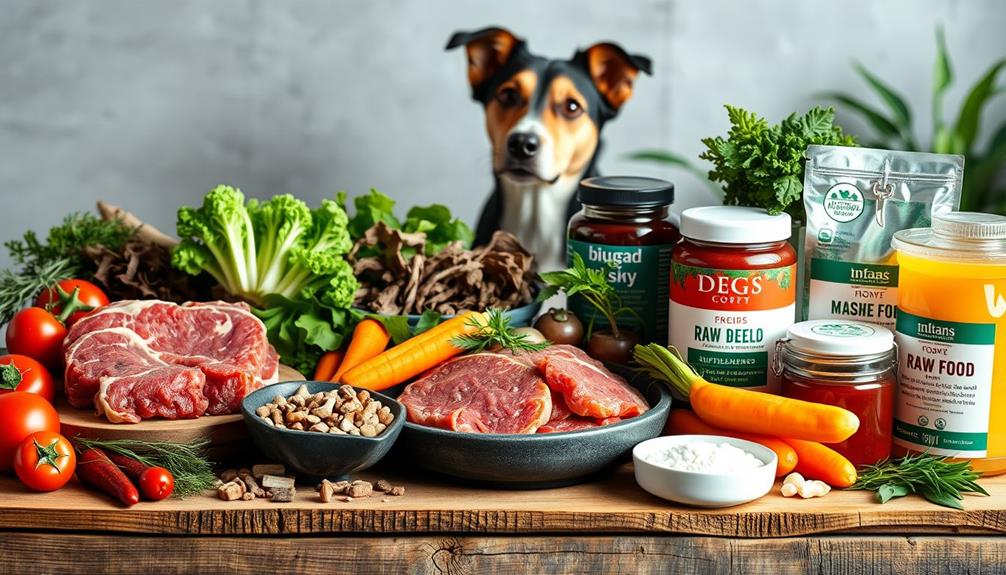
When you're selecting raw dog food, start by evaluating the quality of the ingredients to guarantee they're sourced from reputable suppliers.
A balanced diet is essential for your dog's overall health, just as it's for humans, so consider looking for options that include a variety of nutrients.
Research the company's reputation and quality control practices to minimize contamination risks.
Additionally, understanding the importance of sustainable weight loss can guide you in choosing the right food that promotes your dog's health.
Ingredient Quality Assessment
To guarantee your dog thrives on a raw food diet, evaluating ingredient quality is vital. Start by making sure the diet includes high-quality, human-grade meat sourced from reputable suppliers. This greatly impacts nutritional value and food safety. Look for a variety of protein sources like beef, chicken, and fish to create a balanced diet and minimize nutritional deficiencies.
An important component of ingredient quality is the inclusion of organ meats, which provide essential vitamins and minerals necessary for your dog's health.
Here's a quick reference table to help you assess ingredient quality:
| Criteria | What to Look For |
|---|---|
| Meat Quality | High-quality, human-grade meat |
| Protein Variety | Multiple protein sources (beef, chicken, fish) |
| Organ Meats | Included for essential vitamins and minerals |
| Sourcing Transparency | Clear information about ingredient origins |
| Food Safety Measures | Robust practices to guarantee safety |
Research the raw food brand's reputation for quality control, including sourcing transparency and food safety measures, to confirm you're providing the best nutrition for your dog without compromising on safety or health benefits.
Company Reputation Research
Researching the reputation of raw food companies is essential in selecting the best diet for your dog. Start by examining their sourcing practices to confirm they use high-quality meat and ethically sourced ingredients.
Brands that prioritize transparency in their ingredient lists will specify protein sources rather than relying on vague terms like "meat by-products." Additionally, consider looking into essential oils for respiratory health that can support your dog's overall well-being alongside their diet.
Customer reviews can provide valuable insights into how other dog owners feel about their pets' health and satisfaction with specific raw food options. Look for testimonials that highlight positive experiences and any noticeable changes in dogs' overall well-being.
Additionally, consider companies that have undergone third-party testing for nutritional content and safety, as this verification indicates they meet industry standards.
Don't hesitate to consult with veterinarians or pet nutritionists, who can recommend specific brands based on their understanding of your dog's health needs. They can help clarify which raw food options align best with your pet's unique requirements.
Nutritional Balance Verification
Choosing the right raw dog food involves verifying its nutritional balance to confirm your pet gets everything they need for ideal health. A well-balanced raw diet should include high-quality ingredients, a variety of protein sources, and essential nutrients that meet your dog's specific dietary needs.
It's also important to reflect on the financial implications of switching to a raw diet, as some pet owners may need to budget for higher-quality ingredients or specialty products that adhere to financial considerations for elderly care principles.
Here are some key points to reflect on:
- Ascertain the food adheres to AAFCO guidelines for nutritional completeness.
- Include organ meats and bones to provide crucial amino acids and fatty acids.
- Consult a canine nutritionist or veterinarian to tailor the diet based on your dog's age, breed, and health status.
- Regularly monitor your dog's health and digestive issues after switching to raw food.
Tailoring Diets for Breeds
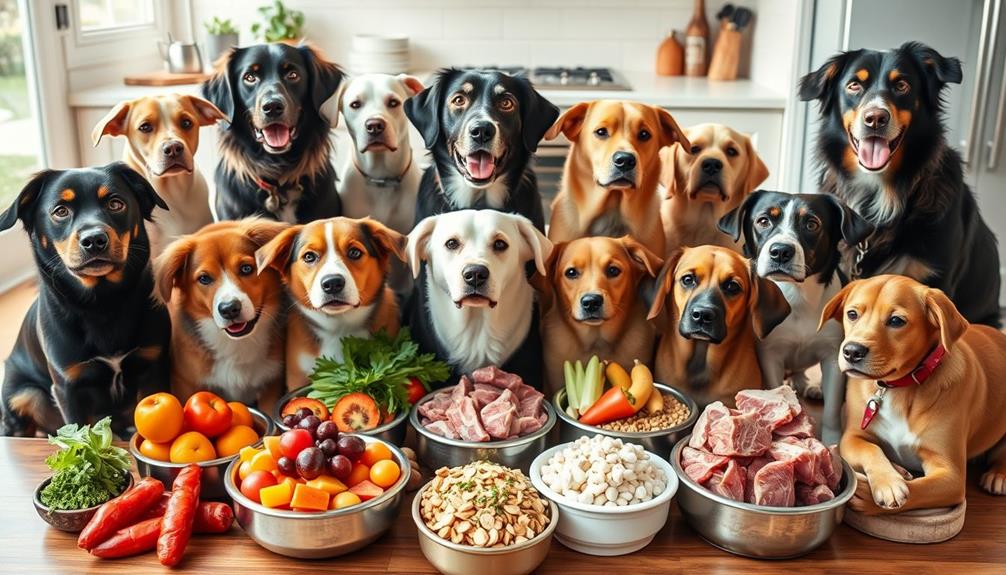
Tailoring diets for different dog breeds is essential for guaranteeing their overall health and well-being. Each breed has unique dietary requirements influenced by size, age, activity level, and specific health issues, similar to how creating a personal budget involves understanding individual needs.
For example, larger breeds often need higher levels of calcium and phosphorus to support strong bones, while smaller breeds thrive on a diet rich in lean protein sources for energy.
If you have a breed prone to obesity, like Bulldogs or Dachshunds, you'll want to control portion sizes and focus on lean proteins in their raw diets. On the other hand, breeds like Greyhounds may flourish on a raw diet higher in fats and proteins, while Cocker Spaniels might need a balanced intake of carbohydrates to prevent skin allergies and maintain coat health.
To guarantee your dog's raw diet meets their individual health needs, consider consulting a veterinarian or a canine nutritionist for breed-specific guidance.
Tailored raw diets can greatly enhance your dog's health, vitality, and overall happiness, so investing time in understanding their specific requirements is essential for their long-term well-being.
Common Transition Challenges
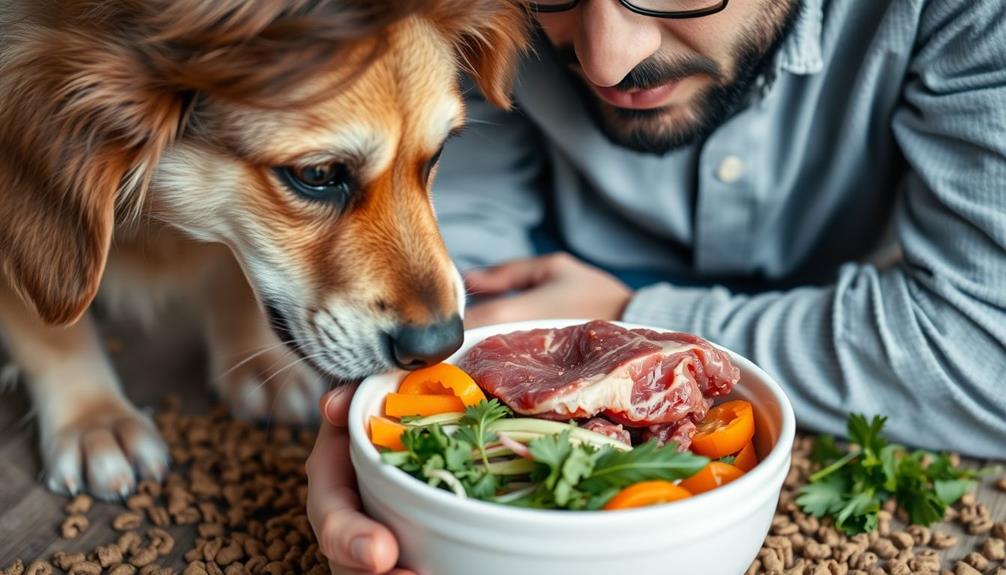
Shifting your dog to a raw food diet can present several common challenges that pet owners should be aware of. Many dogs may experience digestive upset, such as vomiting or diarrhea, particularly if they're older or have sensitive stomachs.
During this changeover, your dog's digestive system may react with detoxification symptoms, including loose stools and runny eyes, which can last from a few days to several months. It's important to monitor their overall health and consider factors that could increase stress on their digestive system, similar to how improper aftercare can affect healing in piercings.
To help ease this process, consider the following:
- Gradually changeover over 7 to 10 days, starting with a small percentage of raw food mixed with their current diet.
- Be patient, as dogs used to kibble may initially reject the new food due to its different texture and aroma.
- Use enticing additives like cheese or broth to encourage acceptance.
- Monitor your dog's response closely; if severe digestive issues arise, don't hesitate to return to a slower changeover or consult your veterinarian.
Resources for Raw Feeding Support

Finding reliable resources for raw feeding support can make your shift to a raw diet much smoother. Joining online raw feeding groups is a great way to connect with other pet owners who've successfully changed their dogs' diets. These groups often share valuable tips, experiences, and meal planning ideas that can address common concerns.
Engaging with holistic veterinarians can also provide you with professional guidance during the change. They understand the benefits of raw feeding and can help guarantee your dog's dietary needs are met. Additionally, utilizing tracking apps can help you monitor your dog's health and dietary changes, making it easier to adjust the diet as needed.
Don't overlook local community events for raw feeders; these gatherings foster connections with fellow dog owners. You can exchange tips, share experiences, and learn from one another in a supportive environment.
Whether you're managing the initial change or maintaining a raw diet long-term, these resources can provide the encouragement and knowledge you need. Remember, you're not alone on this journey—many pet owners are enthusiastic to share their successes and challenges in raw feeding.
Frequently Asked Questions
Can I Just Switch My Dog to Raw Food?
You shouldn't just switch your dog to raw food abruptly. Doing so can cause digestive issues. Gradually introducing the new diet over a week helps your dog adjust better and reduces the risk of gastrointestinal upset.
How Long Does It Take for a Dog to Adjust to Raw Food?
As you introduce raw food, picture your dog's journey—gradually switching over seven to ten days. Watch for signs of adjustment; loose stools might appear, but soon, you'll see improved digestion and energy blooming.
How Should I Introduce Raw Food to My Dog?
To introduce raw food, start gradually over ten days. Mix 75% kibble with 25% raw initially, then increase raw. Monitor your dog's response, and consider adding appealing toppings to encourage acceptance during the shift.
Can I Just Start Feeding My Dog Raw Food?
Jumping into raw food isn't just a jolt; it could upset your dog's digestion. You'll want to gradually introduce it, monitoring their health and adjusting for a smooth, successful change to a new diet.
Conclusion
Switching your dog to a raw diet can be a rewarding journey, and you might be surprised by how quickly your furry friend adapts. Just like a puzzle, each piece—like selecting quality food and monitoring health—fits together to create a vibrant picture of well-being. As you embrace this new approach, you'll likely discover unexpected benefits for both you and your dog, deepening your bond. So, take that leap, and watch your pup thrive!

